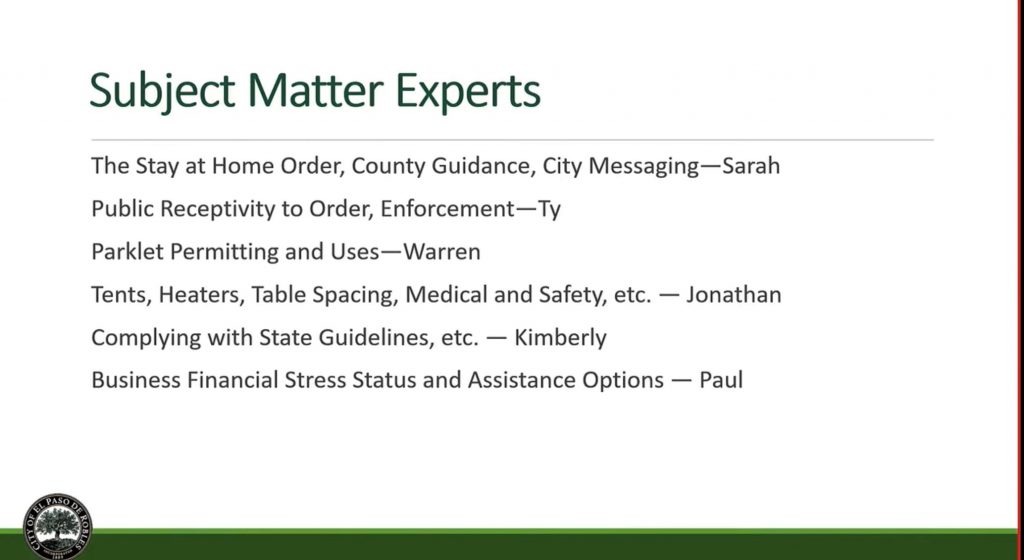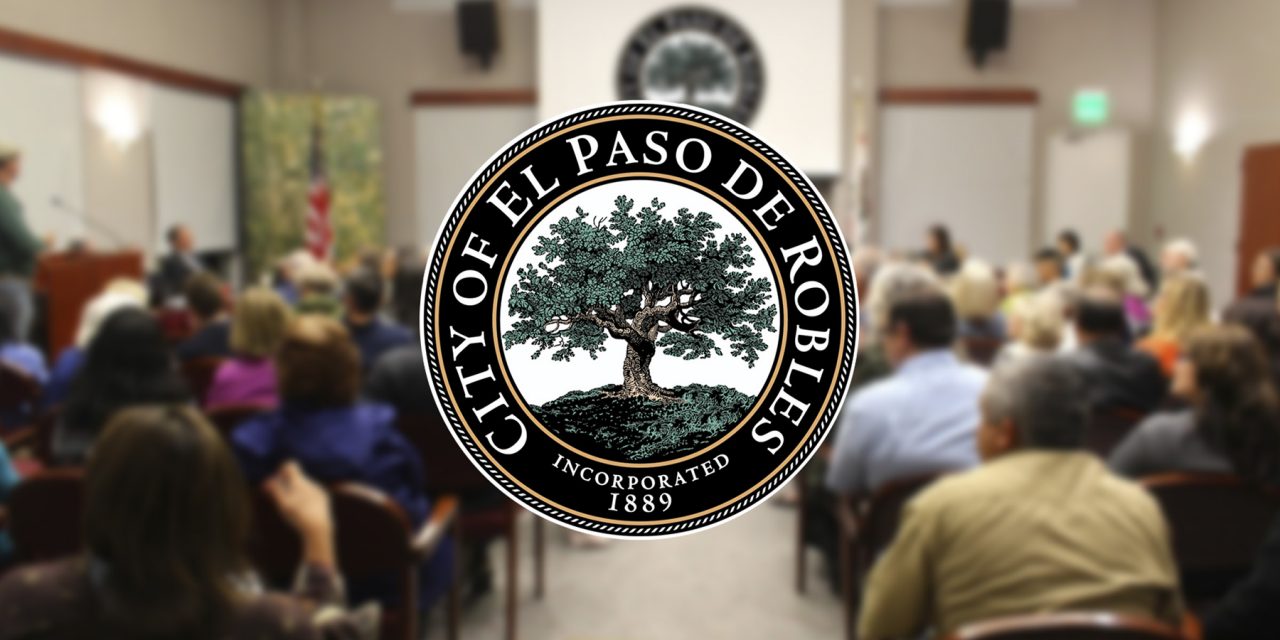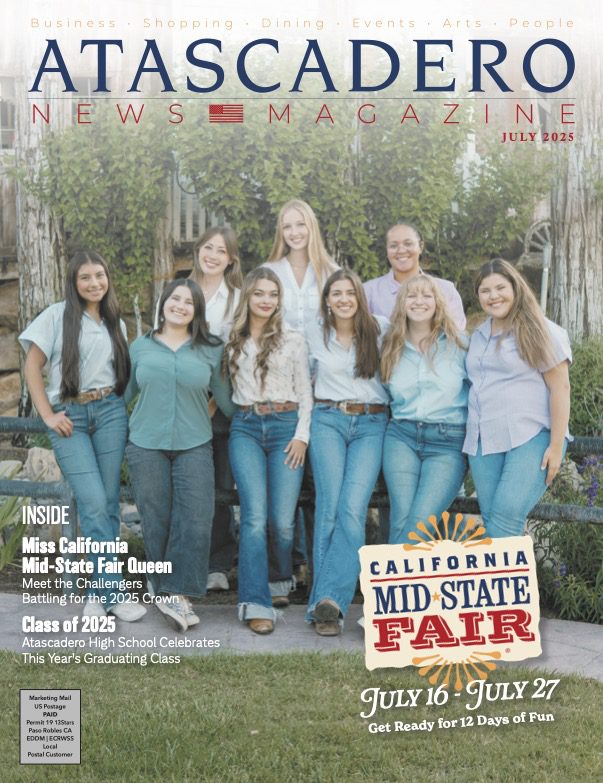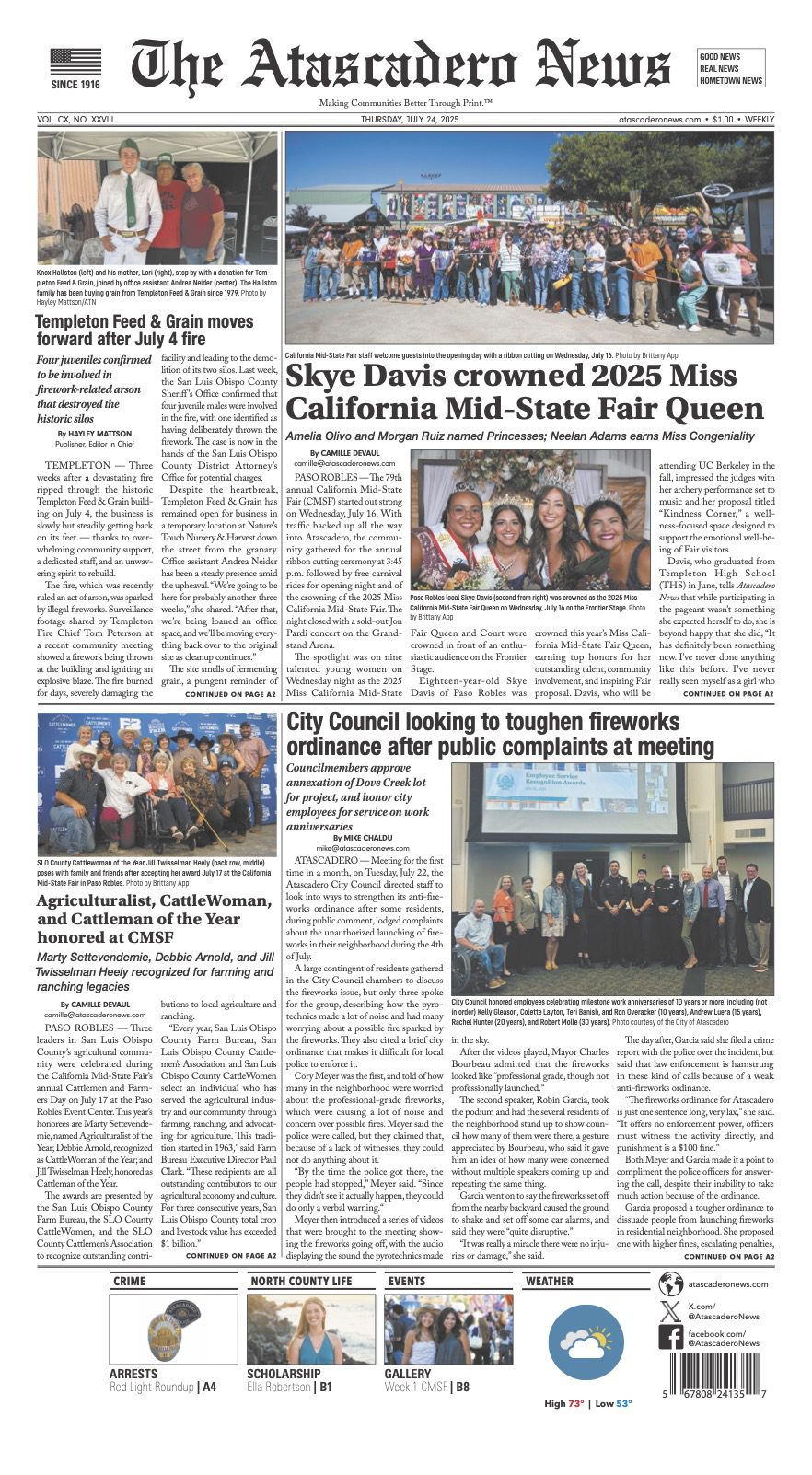After several hours of community comment, and deliberation all five City Council members unanimously vote not to enforce the shelter-at-home orders and revert back to purple tier restrictions.
PASO ROBLES – In a special meeting on Thursday, Dec. 10 at 6:30 p.m., the Paso Robles City Council met to discuss the latest Stay at Home Order issued by Governor Newsom that went into effect on Sunday, Dec. 6 at midnight.
The council’s special meeting was called to address the “Business Viability and the Governor’s New Stay at Home Order.”
After a call to order by Mayor Steve Martin, he turned the meeting over to Tom Frutchey, Paso Robles City Manager, who stated up front that “this is a rapidly evolving situation and they wanted to get it to the council as soon as possible.”
Frutchey continued by first explaining that he would be giving an overview of the topics; however, they have experts within the City that were available for further questions who all were in attendance.

Frutchey started by reviewing the San Luis Obispo County’s current COVID-19 case counts and hospitalizations, which lead into the “Regional Stay at Home Order” that the Governor released on last week.
The regional stay-at-home order was implemented in regions with less than 15 percent ICU availability and prohibited private gatherings of any size. In addition, Newsom announced that all non-essential travel was restricted statewide starting on Dec. 3 until further notice.
Under the new stay-at-home order, essential businesses such as grocery stores must operate at 20 percent capacity; bars, wineries, salons, and restaurant dining were ordered to shut down; and hotels could only be open for critical infrastructure support.
Schools could remain open if they’ve received a waiver, and restaurants could continue take-out and delivery services.
The order was to remain in effect for at least three weeks and, after that period, would be lifted when a region’s projected ICU capacity met or exceeds 15 percent. This was to be assessed weekly after the initial three-week period.
The state released a map of five regions and their current ICU capacity and projected dates when regions would fall below the 15 percent threshold. San Luis Obispo County, for the first time, was placed in the “Southern California Region,” which included:
• Southern California: Imperial, Inyo, Los Angeles, Mono, Orange, Riverside, San Bernardino, San Diego, San Luis Obispo, Santa Barbara, Ventura
Newsom also stated at that time that the state would be “redirect dollars” if counties defy orders and don’t enforce protocols, instead giving them to “more deserving” counties.
Frutchey explained that San Luis Obispo County still has 40 percent of ICU beds available and that the three counties San Luis Obispo, Santa Barbara, and Ventura have 26 percent of those beds available.
As a part of the States Emergency Response System, different breakdowns in terms of how the counties are grouped together.
Frutchey explained, “in fact in that system it is SLO County, Santa Barbara County, and Ventura County and with an ICU of 26 percent we would not have the stay at home order in effect we would be back in the purple tier— the most restrictive tier — but it is something that the public was getting used to and understood and felt, for the most part, they could accommodate.”
He continued, “The rest of the Southern California Region has only 10 percent of the ICU beds available, so we have been lumped into other counties which we have very little in common. As a result, immediately upon the Governor’s issuance of the order, Mayor Martin started contacting the other mayors and sought all cities to send a letter to the Governor requesting that we be pulled out of the Southern California Region. While the Mayor was in that process, the three county boards of supervisors took up a similar action, and in fact, all three boards how now written letters to the Governor requesting that the three counties be put into a new sub-region independent sub-region at the end of this initial three week period and the order as the gov laid it out would last for at least three weeks.”
As of last night, Mayor Martin’s initiative was still being considered by the other cities, San Luis Obispo was scheduled to meet last night, and Atascadero is reported to meet in a special session on Tuesday, Dec. 15.
Frutchey went on by saying that that the decision is still being analyzed whether letters from all seven city councils in the county would make more impact on the Governor or one letter from all seven cities.
Referring back to the staff report of the two recommendations, Frutchey addressed the second option, first stating that it was the most straight forward option:
Authorize the Mayor to work collaboratively with the other cities to send a combined letter or multiple letters to the Governor supporting the three counties’ Board of Supervisors’ letter requesting that the three Central Coast counties be pulled from the Southern California region.
Frutchey stated that they would open discussions on this topic at the end of the meeting. He then moved onto how the stay-at-home order has impacted local small businesses as well as some larger ones like Park Cinemas, with whom they have been in significant discussion with.
He explained that the small businesses have been especially hit hard, and many have noted that complying with this new order would be devastating to their businesses, and some stated that if they had to close, they would not be able to re-open.
As the meeting continued, Frutchey went over some of the key options that the council needed to discuss and agree upon so the City would know how to proceed going forward.
He stated that after all the months of working through the pandemic with the community, he felt both the business owners and individuals were responding really well and taking personal responsibility, and, for the most part doing everything they can to meet the challenge. He also noted that as he walks around town, he sees almost everyone wearing a mask and social distancing when they can, which he stated was significantly different from back in July.
Some of the key questions that the city staff brought to the council is:
- What approach will the City take?
- What level of enforcement do they want to take?
- How long should they stay with this approach?
Regarding the approach, Frutchey explained that some of the options could be to do nothing, continue as is, targeted assistance opportunities, or take the Solvang/Manhattan Beach approach.
On Dec. 7, the Solvang City Council met in an emergency meeting to respond to Gov. Newsom’s recent stay-at-home order and its impacts on the community; after much consideration, they decided the City would not enforce it.
http://www.santamariasun.com/news/20165/solvang-urgently-responds-to-new-state-restrictions/
As for Manhattan Beach, they counter LA County’s Outdoor Dining Ban With an “Outdoor Seating” Plan.
As Frutchey’s presentation continued, they discussed what would qualify as an “Egregious Violation,” citations, and maintaining “fairness” between all businesses.
That led Frutchey back to the first key question of direction:
Provide a balanced level of support to local businesses in their efforts to find a path that keeps their employees and patrons safe, helps preserve their business viability, and meets community needs regarding public health and safety.
Mayor Martin resumed control of the meeting and addressed the council and the staff, stating that he would open it up for council questions and clarifications prior to public comment. At that time, an estimated 18 people were already on the phone line, ready to address the council.
Martin said, “It is good to see that the message got out about this meeting. It is very important to our community to our communities physical health as well as fiscal health, so we want to give it the time and attention it deserves that it deserves and come up with a solution that is unique and fitting for the community of Paso Robles, not something someone else has done or what someone else says we should do.”
A few questions brought up by councilmembers addressed mental health, how the state formed the regions, an overview of different violations that had been called in, and the guidelines/mandates enforceable by law.
In addition, Jonathan Stornetta gave clarification on how the decision was made to form a new region with Santa Barbara and Ventura as opposed to Monterey and Santa Barbara. He explained, “that if you look throughout the state of California the office of Emergency Services designates the southern California Region from San Luis Obispo County south to the San Diego border anything north of San Luis Obispo County would be the Northern Region there has not been any history of incorporating Monterey County.”
As public comment opened, 24 people were waiting in line to address the council. Callers’ comments ranged from concern for holiday travel, the favor of the “Solvang approach,” priorities with law enforcement, and the devastating effects on the local economy.
Among the calls for support for local businesses was shared by Marjorie Hill.
“I don’t agree with closing our downtown businesses; I don’t agree with closing hair salons, nail salons, and fitness centers. These are the small businesses that form the backbone of our community; it’s not just the owners, it’s the employees, it’s the service delivery people that come and bring supplies for these businesses, and I just think that the Governor is trying to kill small businesses.
“I am completely against that. I don’t think there should not be any progressive enforcement. I think that the people that complain are not considering what the effect of their complaint is on these small businesses.
“Why does Santa Claus get 11 complaints for being outside? I just don’t understand that at all; I think that the cure is worse than the disease. I agree with the other speaker who commented about the numbers in our county; it does not make any sense for us to be lumped with LA, and I think that the mayor should go ahead with the plan to write the letter to the Governor to remove our county. I think we should go back to the purple tier…”
Paso Robles Main Street Founder Norma Moye called in and shared her complete frustration.
“I am angry Steve, Mayor Martin,” Moye said. “I live down here I eat down here, I’ll tell you this town, everyone has a mask on everybody makes you wash your hand everybody is really complaint now what I don’t understand there is no need to shut down our businesses when there is no violations that I can see.
“What more do they want us to do … say you owned a business would you like it if spent your entire life all your money everything and now you have to shut down again and starve to death I want to see us removed from the Southern California Region … everyone in Paso is doing what they are supposed to be doing and they are we have all worked very hard to comply … I know it is a bad disease but so is the flu, please, please let our merchants do their business.
“If you are scared, they are really governing us by fear and if you are afraid to go in somewhere then … don’t go in there … bless these merchants they are all … I’m upset Steve … please let our businesses stay open, put yourself in their shoes.”
Other callers ranged from business owners addressing the hardship this shutdown has brought to them and other businesses, as well as the concern that there is not enough micro-grants available to save our small businesses.
Sally Reynold’s called in a stated she is scared to death of the virus, her immediate family was sick, and she does not think that “45 deaths are anything to sneeze at. Those were somebody’s loved one.”
She disagreed that we should not be tied into the southern region and was supportive of the Mayor writing the letter but stated that Paso is tied in and “no one is following the rules.”
After a little over two hours and more than 50 phone calls, the public’s overall consensus was to follow Solvang and not enforce the mandate and allow businesses to operate in a “safe and open manner.”
“[Paso Robles] is not to be like Solvang, I am not about being like another city,” Councilmember John Hamon said, “but I would support strong council leadership and direction to staff to hold our Paso Robles level of reasonable restrictions to a purple tier level or at least again until we see the ICU level is rising to the point where it is dangerous level or 15 percent or less.
“I would also continue law enforcement policies that we have already previously said, but I would not support any administrative citations as far as the egregious violators who do not want to adhere to the purple tier; we need to go after those people, and I believe Chief Lewis would agree with too, we all need to be as safe as possible and yet still continue our business to keep our folks going.
“We would also like to continue to work with our Chamber and Main Street Association to address needed support in these purple tier compliances. I think that is a very important partnership … we also need to honor and respect our city government’s civic responsibility to keep our financial security stable by supporting our businesses; if our businesses fail, our City is going to fail, and that is as simple as it goes.”
After another 30 minutes of discussion, understanding the risks – a motion was proposed by Mayor Martin after all council members agreed with the overall support for Councilmember Hamon’s proposal.
“I move that we maintain the purple restriction level in the City of Paso Robles and that we support the redesignation of our county moving it out of the LA statical area for the purposes of COVID evaluation,” Martin said, “that we continue our course of empathy and education using our Chamber partners and local businesses that we allow our public health officer at the county level to designate what indeed is egregious or flagrant and let us know of those incidents.
“I don’t think that we need our officers in the field making those decisions, and finally I think as far as the length and course of action I think that this would stay in effect until review is needed based on local developments or new state mandates.”
“Second; that is perfect,” said Councilmember Gregory.
The decision was also made to include that Mayor Martin would work with all local mayors to sign the letter to remove San Luis County from LA County.
Votes were pulled from all 5 Council Members, and the motion passed 5-0.
City Council meetings are live-streamed and available to play on YouTube by accessing the following link: prcity.com/youtube.













